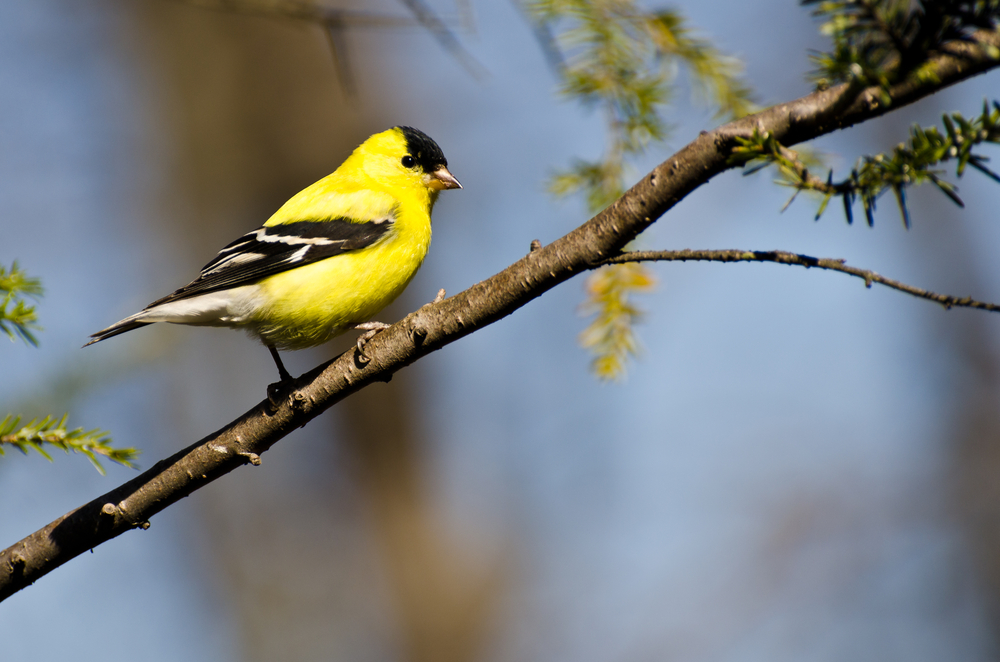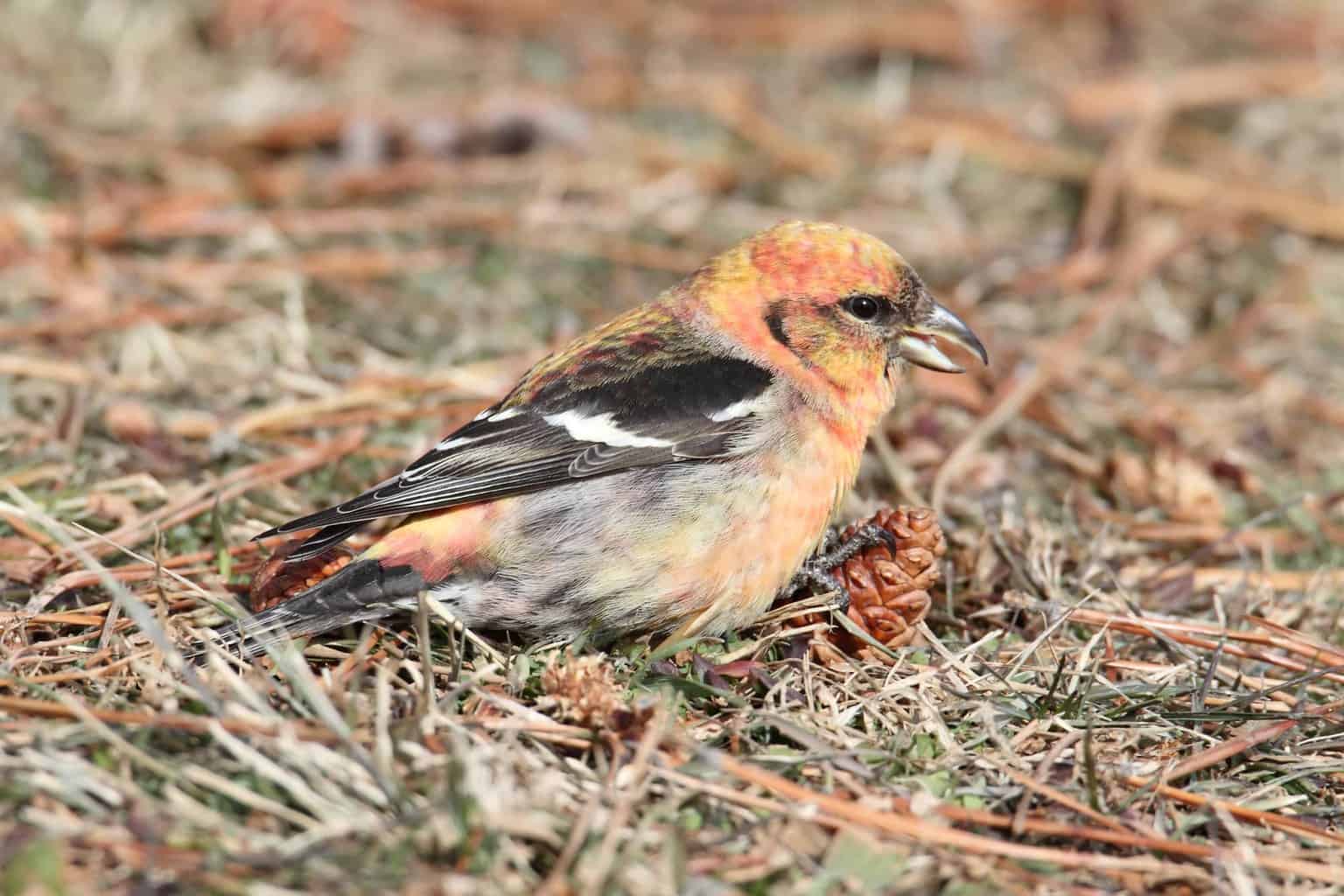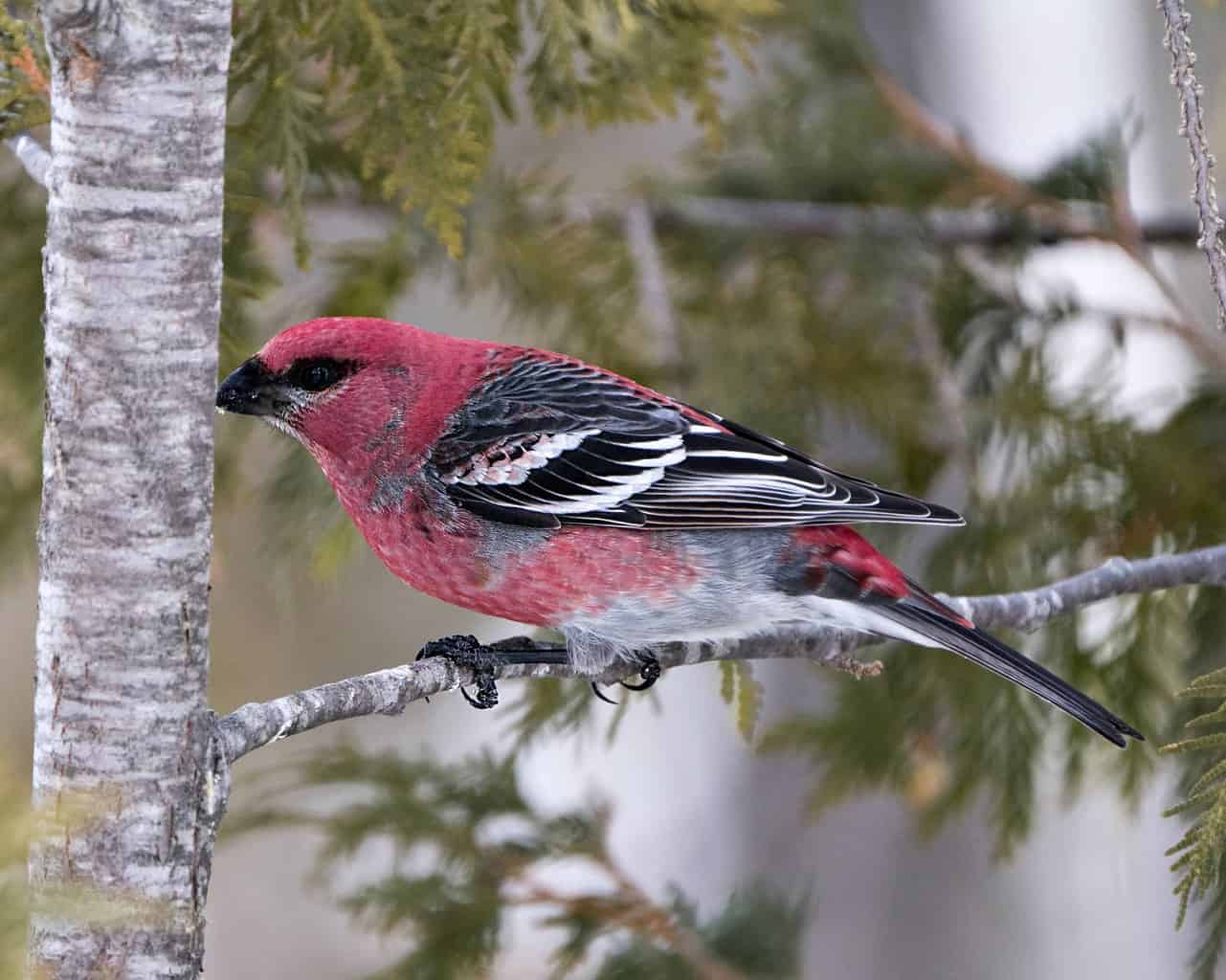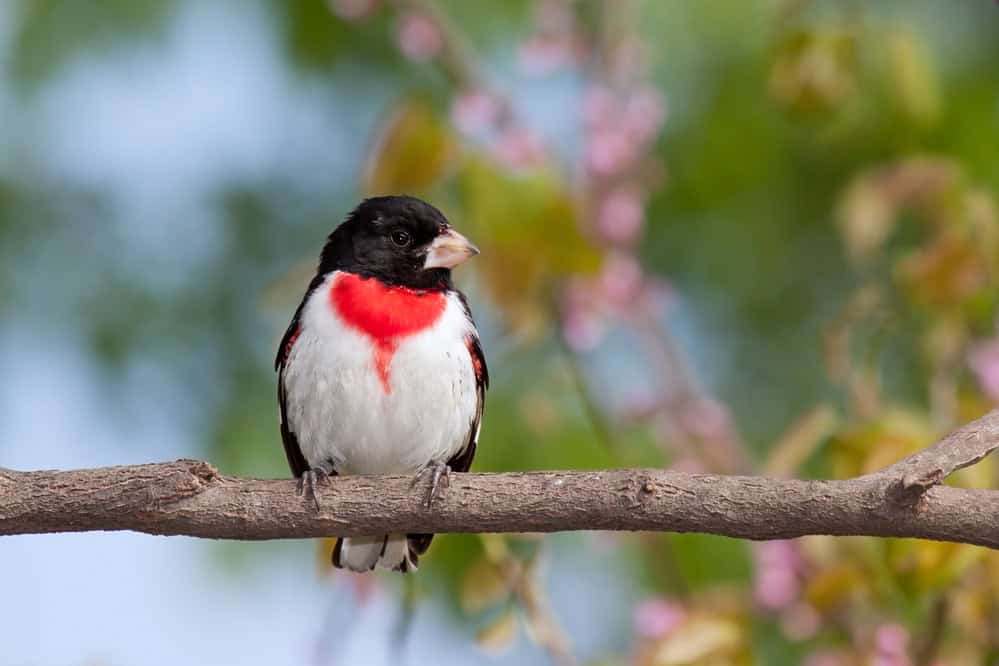With lush forests and massive lakes, Michigan is a nature lover’s paradise. If you’re eager to level up your bird watching, you’ll be pleased to know you can spot 11 finches throughout the state!
Finch species are adaptable birds, often comfortable in urban environments as well as forested areas. Michigan has a thriving agricultural industry that overlaps well with finches’ diverse diets, so you won’t have to travel far to spot them.
We’ll help you identify and understand different finch species so you can increase your chances of spotting them. The guide below has bird-feeding tips, fun facts, and much more.
American Goldfinch

- Species Name: Spinus tristis
- Length: 11 cm to 14 cm
- Weight: 11 grams to 20 grams
- Wingspan: 19 cm to 22 cm
You won’t have to search very hard for this charming fellow. The American goldfinch appears in Michigan year-round and has a vibrant appearance that’s easy to spot.
Appearance
The male American goldfinch is the color of a bright lemon, boasting a black smudge on its forehead and dark wings. Both their beaks and legs are yellow-orange.
However, the American goldfinch will shift into a more subtle olive during the winter. As such, you may confuse them for a female!
Female American goldfinches are a light yellow-brown year-round, but they may brighten up a little during the summer.
Range
This finch is very comfortable in Michigan’s many forests, fields, and mountains. They’ll also crop up near roadsides and meadows with more human activity.
If you prefer to go on long, slow walks in the park, you’ll likely see a few hanging around. This is the kind of finch that’s very accessible no matter your bird-watching style.
Diet
The American goldfinch’s diet revolves around seeds and grasses. While you’ll spot them throughout Michigan pretty easily, you can attract them to your backyard with nyjer seeds.
Birdsong
These beautiful birds have a delicate call of tweets and chirps. Expect a repetitive twi-twi-twi broken up by the occasional whistle or twee.
Fun Fact
Are you a fan of pet birds, too? Domesticated canaries are closely related to wild finches.
Purple Finch

- Species Name: Haemorhous purpureus
- Length: 12 cm to 16 cm
- Weight: 18 grams to 32 grams
- Wingspan: 25 cm
I’m a big fan of rosy-colored birds. The purple finch may have a misleading name, but it’s a real charmer for the bird-watching photography portfolio.
Appearance
The male purple finch almost looks like it was splashed with berry juice, coated in a vivid bright pink. They have brown wings, a short bill, and a white rump.
Female purple finches almost appear like a common sparrow, covered in white and brown streaks. They have brown patches beneath their eyes and a pale bill.
Range
Purple finches usually show up in Michigan year-round, so they’re another beginner-friendly finch to add to the list. They’re fond of conifer forests where they can crack open cones and dig out seeds.
If you feel like going on a legendary Michigan nature walk, you may spot them around streams, too.
Diet
Purple finches have a diverse diet of insects, seeds, and fruit. They love to forage in bushes and trees but are more than happy to visit backyard bird feeders.
Stock up on sunflower and nyjer seeds to invite them over. They’re also fond of millet.
Birdsong
Their birdsong is sweet and simple, composed of a twittering warble with long pauses in between.
Fun Fact
Purple finches and house finches are easily confused due to their similar coloration. Speaking of which…
House Finch

- Species Name: Haemorhous mexicanus
- Length: 13 cm to 14 cm
- Weight: 16 grams to 27 grams
- Wingspan: 20 cm to 25 cm
Another easy bird to spot throughout Michigan’s abundant wildlife is the successful house finch. These common birds have quite a range throughout North America.
Appearance
The male house finch may appear like a male purple finch at a glance, but keep an eye on its back. This bird has more brown and gray along its back and wings.
The female house finch is entirely gray and brown with streaks along their face.
Range
A testament to the house finch’s success is how easily they blend into urban and natural environments. They’re just as likely to hang out in a park or a backyard as they are to visit a forest.
You’ll see this bird year-round and may even encounter it in cities.
Diet
These seed-eating birds are active and curious foragers, though they’ll sometimes dine on berries. If you want to bring them to your backyard, stock up on black oil sunflower seeds and nyjer seeds.
Birdsong
The house finch is a chatty bird, letting loose complex warbles and simple cheep-cheeps alike. They’ll even trill once in a while!
Fun Fact
Bird catchers introduced this species to Long Island, New York back in 1940. They would proceed to become one of the most adaptable and widespread birds in the country!
Common Redpoll

- Species Name: Acanthis flammea
- Length: 11 cm to 14 cm
- Weight: 12 grams to 16 grams
- Wingspan: 19 to 22 cm
These stocky birds are simply adorable, often fluffing up to the point of looking like a plush toy. When you consider how cold Michigan gets during the winter, it’s a reasonable response!
Appearance
Adult males have a white and gray body with a distinctive red splotch on their forehead. You’ll also see a dusting of pink along their chest, almost like they’re blushing.
Female common redpolls look almost identical but don’t have pink along their chest.
Range
Expect to see them crop up in Michigan during the winter, lingering in boreal forests where they like to forage for food. You’ll find more of these types of forests on the islands of the Great Lakes.
Diet
These birds are quite fond of birch and alder seeds. If you want to attract them to your backyard, try stocking up on nyjer or shelled sunflower seeds instead.
Watching these birds crack open and eat their favorite foods is one of the most relaxing ways to enjoy Michigan wildlife.
Birdsong
Their birdsong is often repetitive and chirpy, interspersed with rapid-fire chr-chr-chrs and the occasional trill.
Fun Fact
Want a bird-watching challenge? The common redpoll often looks similar to the hoary redpoll, but I’ll give you a few tips…
Hoary Redpoll

- Species Name: Acanthis hornemanni
- Length: 12 cm to 14 cm
- Weight: 12 grams to 16 grams
- Wingspan: 20 cm to 25 cm
What are some of your favorite songbirds to seek out? I’m in love with birds who boast splashy feathers and the hoary redpoll is a fantastic example.
Appearance
The hoary redpoll has a pale body flecked with brown, and white wings. They have a bold red spot on their forehead and a rather small beak, giving them a pouty look.
They have a little pink on their chests, too.
Female hoary redpolls are almost entirely white and boast the same red patch on their foreheads. They don’t have pink on their chests.
The biggest difference between common redpolls and hoary redpolls is that the latter is paler. They have fewer streaks and smaller beaks, too.
Range
These birds usually prefer the arctic tundra, their pale feathers letting them blend in with the snow. As such, they’re a rarer sight in Michigan and may take more dedication to find.
When they do show up, it’s usually in the winter months (and when they can’t find much food elsewhere).
Diet
These finches live on a seed-based diet. Hoary redpolls don’t turn down easy meals, so bring them to your backyard with nyjer or black oil sunflower seeds.
Birdsong
Their song is a brisk and repetitive melody, composed of cheet-cheet-cheets usually in three-note or five-note successions.
Fun Fact
This bird is called the arctic redpoll in Europe and the hoary redpoll in North America.
Red Crossbill

- Species Name: Loxia curvirostra
- Length: 20 cm
- Weight: 40 grams to 53 grams
- Wingspan: 27 cm to 29 cm
Not all finches have round, conical bills. The red crossbill earned its title for its unique twisted beak shape that allows it to dig inside pine cones.
Appearance
The male red crossbill can actually vary between a brick red and a red-orange. They have brown-black wings, dark legs, and a dark bill.
Keep a close eye out for their two bold, white wing bars.
Female red crossbills are usually lighter, often boasting yellow-orange coloration with otherwise similar colors to the male.
Range
Since they rely on pinecones as their main source of food, red crossbills are usually roaming coniferous forests. Pine, spruce, and fir trees are among their favorites, so it’s no wonder that they’re comfortable in Michigan.
They show up year-round in northern Michigan but are much more rare in the southern part of the state.
Diet
Conifer seeds are their favorite food to eat. You can try enticing them to your backyard bird feeders with sunflower seeds, though!
Birdsong
Red crossbills have dynamic, undulating songs of chee-chee-chee and short twitters. They have a tinny or metallic ring to their call.
Fun Fact
This finch also goes by different names – the red crossbill in North America, but Europe calls them the common crossbill.
White-Winged Crossbill

- Species Name: Loxia leucoptera
- Length: 15 cm to 17 cm
- Weight: 25 grams to 40 grams
- Wingspan: 26 cm to 28 cm
The white-winged crossbill can be tricky to separate from the red crossbill. However, there is one main distinction that should make things easy for you.
Appearance
First things first – the white-winged crossbill is also quite red with dark wings and two white wing bars. They have a forked tail and a little banding around the eyes.
You’ll notice their wings are usually darker than a red crossbill’s, making them appear more bold.
Female white-winged crossbills are light yellow-green with dark streaks on their stomach.
Range
These finches show up in northern Michigan year-round but are rare in the southern portion of the state. They stick predominantly to forests but might be enticed to your bird feeder.
Diet
White-winged crossbills eat a diverse diet of seeds, insects, and berries. They usually prefer seeds due to the unique design of their bill.
While they don’t usually visit people’s backyards, try to attract them with a hearty helping of sunflower seeds. You may see this finch show up for an easy lunch.
Birdsong
White-winged crossbills have a charming song of chatters and trills. They sometimes let out a peet-peet pattern.
Fun Fact
The white-winged crossbill also goes by different names – they’re sometimes called the two-barred crossbill.
Pine Siskin

- Species Name: Spinus pinus
- Length: 11 cm to 14 cm
- Weight: 12 grams to 18 grams
- Wingspan: 18 cm to 22 cm
This tiny finch is a real charmer due to its lively personality and constant chatter. You won’t have a hard time seeing or hearing them when you travel to Michigan.
Appearance
The male pine siskin has a light yellow-brown body covered with little streaks. Their bill is a light gray and their tail is on the shorter side.
Female pine siskins look very similar to the males.
Range
You’ll find the pine siskin in northern Michigan year-round. They become a rarer sight in southern Michigan, but you’ll still run into a few during winter.
Coniferous forests are their main squeeze, but you’ll also find them in parks, meadows, and backyards. They also visit roadsides to get a few nibbles of salt.
Diet
While pine siskins prefer to eat plants and seeds, they’ll munch on the occasional insect. They’re also fond of salty mineral deposits to get some extra nutrients.
They’re fans of backyard feeders, so stock up on nyjer and sunflower seeds.
Birdsong
The pine siskin has a rising and falling warble mixed with a strained zweeeee.
Fun Fact
The pine siskin has a rather dynamic migration pattern, making it less predictable than other finches.
Pine Grosbeak

- Species Name: Pinicola enucleator
- Length: 20 cm to 25 cm
- Weight: 52 grams to 78 grams
- Wingspan: 33 cm
These finches are on the larger side, which is just one of the many details that make them stand out!
Appearance
The male pine grosbeak is a large and stout finch, boasting a red body with gray wings and a dark bill. They often have a little gray around their rump.
The female pine grosbeak has a mostly gray body with a dusting of yellow on her head and rump. They can also look similar to young males that haven’t developed their full plumage yet.
Range
Coniferous forests are their favorite place to eat and breed. They’re rather rare in Michigan because they usually prefer the West or Canada, but you may see a few during winter.
Diet
Pine grosbeaks eat a hearty diet of flower buds, insects, berries, and seeds. If you want to attract a few to your feeder, it’s important to keep in mind their size.
Since they’re larger than so many finches, they need a platform feeder to support their weight. Fill it up with fresh sunflower seeds and enjoy the show!
Birdsong
Pine grosbeaks have a warbling and lively call that can seemingly continue without end. Their notes rise and dip in ongoing whistles.
Fun Fact
Pine grosbeaks have a useful sac that they use to store food and feed their young.
Evening Grosbeak

- Species Name: Coccothraustes vespertinus
- Length: 16 cm to 22 cm
- Weight: 38 grams to 86 grams
- Wingspan: 30 cm to 36 cm
Another stocky bird to add to your must-see list is the dazzling evening grosbeak. They’re large enough to seem more like a robin than a finch!
Appearance
The male evening grosbeak has a bulkier body, boasting striking yellow plumage with a black head and black wings. They have white wing bars and a yellow stripe over their eyes.
Female evening grosbeaks have yellow-gray bodies with black and white wings. They usually have a dusting of yellow along their neck.
Range
Expect to see this easily recognizable finch in Michigan’s coniferous forests, particularly up north. However, their range often expands during winter.
Diet
These birds are curious foragers, often on the ground looking for a wide variety of berries, seeds, or insects. However, they’re not opposed to visiting your backyard if you stock up on sunflower seeds.
Make sure to use a platform feeder to support their larger weight.
Birdsong
Their call is simple and blunt, often sounding like a sharp chew with long pauses in between.
Fun Fact
Their genus name is a treat for fans of language study. The label Hesperiphona is a blend of Latin and Greek words, meaning ‘evening cry’.
Rose-Breasted Grosbeak

- Scientific Name: Pheucticus ludovicianus
- Length: 18 cm to 22 cm
- Weight: 35 grams to 65 grams
- Wingspan: 29 cm to 33 cm
Wrapping up the list with the stunning rose-breasted grosbeak, this is one bird you won’t have to jot notes for. Their appearance is extremely unique among finches.
Appearance
The male rose-breasted grosbeak has a black body, white belly, and an iconic red splash on their throat. They’re also a little larger than other finches and have a very pale bill.
The female rose-breasted grosbeak has a light brown and white body with heavy streaking on the stomach. They also have a white patch over their eyes that almost looks like an eyebrow.
Range
These finches usually show up in Michigan during breeding season and are very rare any other time. Deciduous forests are their ideal place to explore and forage for food.
Diet
Rose-breasted grosbeaks will forage shrubs and bushes for berries, insects, or seeds. They also like to sup on a little nectar to shake things up.
Thanks to their larger size, don’t expect to see them at a tube feeder. Sprinkle sunflower seeds onto your platform feeder to attract them.
Birdsong
Their call is exceptionally sweet and high-pitched, often sounding like a twee-twer-ree. They’ll sprinkle in a few warbles and will sometimes pause before letting loose another song.
Fun Fact
Female rose-breasted grosbeaks can sometimes look similar to the black-headed grosbeak.
Michigan Is an Unforgettable Birdwatching Location
It doesn’t matter if you prefer to hike, go on slow nature walks, or enjoy boating trips. Michigan’s diverse landscape makes birdwatching easy no matter your hobby.
This state is a prime choice for bird watchers who enjoy photography, due in no small part to its incredible vistas. Test your skills by getting snapshots of birds against the Great Lakes or one of the state’s many forests.
Want to check out more birds while you’re in the state? We have a guide on birds in Michigan ready to help you out.

